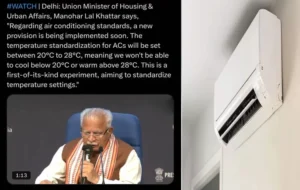 New Delhi: In a first-of-its-kind move, the Indian government is set to introduce new rules to standardise air conditioner temperature settings across the country. Union Minister for Housing and Urban Affairs, Manohar Lal Khattar, on Tuesday announced that ACs will soon not be allowed to cool below 20°C or heat beyond 28°C.
New Delhi: In a first-of-its-kind move, the Indian government is set to introduce new rules to standardise air conditioner temperature settings across the country. Union Minister for Housing and Urban Affairs, Manohar Lal Khattar, on Tuesday announced that ACs will soon not be allowed to cool below 20°C or heat beyond 28°C.
This announcement comes as Delhi and several other parts of India battle an intense heatwave, with the India Meteorological Department (IMD) issuing an orange alert for the national capital.
“Soon, a new provision will be enforced where all ACs must operate within a set temperature range of 20°C to 28°C. This is a unique experiment aimed at standardising air conditioning use across India,” said Khattar, who is also the former Chief Minister of Haryana.
Explaining the move, Khattar said that the minimum cooling limit of 20°C and maximum heating limit of 28°C will ensure uniform use of air conditioners in homes, offices, and vehicles. This measure, he said, will help reduce excessive energy consumption caused by setting ACs to very low temperatures.
What will change for AC users?
Once the new rule is implemented, all air conditioners in India will have a restricted temperature range. Users will no longer be able to set their ACs to extremely low temperatures like 16°C or 18°C, which are common in many households and offices. Instead, cooling will start at 20°C and heating will not exceed 28°C.
Both residential and commercial setups will be expected to follow these guidelines, with authorities monitoring the rollout and its effect on energy savings.
Why this decision now?
According to government sources, this step is aimed at reducing the pressure on India’s electricity grid, which faces heavy demand during summer due to widespread AC use. The decision is also part of an effort to promote responsible and efficient energy consumption.
The Bureau of Energy Efficiency (BEE) has highlighted that raising AC temperatures even slightly can lead to big energy savings. Current data shows that while most AC users set their cooling between 20°C and 21°C, the ideal comfort temperature is 24°C in homes and cars, and 24–25°C in commercial buildings.
Increasing the AC setting from 20°C to 24°C alone can cut electricity use by up to 24%. Moreover, for every 1°C rise in temperature, energy use drops by nearly 6%, according to the BEE’s 2020 guidelines.
The move is likely to have a wide impact on air conditioner use across the country, especially in cities battling extreme temperatures, and could set a precedent for similar energy-saving measures in the future.
